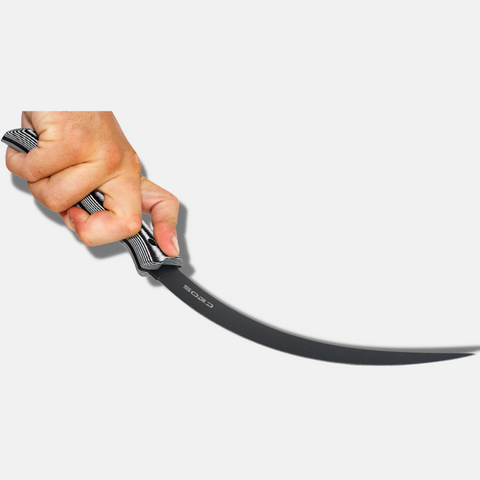A Comprehensive Guide to Fillet Knives
Fishing is not just a hobby for us; it's a way of life. We created SORD for the “crazy ones.” The ones who have an insatiable desire to get out to where the map turns blue. You know, the place that we spend all day dreaming about while we're in the office. It’s a place that we hold near and dear to our hearts. It’s where memories are made, friendships are built, and where grandpa taught us how to bait our first hook. There is something special about getting home from a long fishing trip and hanging around the fish cleaning table with the people who you just spent all day fishing with. When we first started SORD we wanted to build a product that would be a natural part of that moment. That is why we began to build the best fillet knife that the world has ever seen.

In this comprehensive guide, we explain the reasoning and choices that we had to make when building what we believe to be the world’s best fillet knife.
The Importance of a Good Fillet Knife
Have you ever tried to fillet a fish with a regular kitchen knife, or maybe a hunting knife? It is extremely hard to get the right cut due to the contours of a fish’s bones. Fillet knives feature a thin, flexible blade that allows you to run your blade easily along the contours of the fish’s bones, ensuring that you get every last piece of fillet off the fish that you worked all day to catch.
It also makes a huge difference to pick the perfect fillet knife for your type of fishing. We will walk you through how to choose the perfect fillet knife below.
Choosing the Perfect Fillet Knife
There is an overwhelming amount of knives on the market, so choosing the right one can be quite overwhelming. We have highlighted what you need to focus on when choosing the best fillet knife for the fish that you are chasing.
Blade Size: If you are going to be cleaning bigger fish from offshore such as mahi, tuna, or wahoo, we recommend that you get a longer blade which will allow you to make clean, efficient cuts through bigger pieces of meat. If you are fishing inshore for redfish and speckled trout, you might want a fillet knife that is shorter than your typical offshore knife. You will find that fish cleaning knives come in all different sizes from 4 inch blades to 12 inch blades, find the size that works best for you.

Blade Material: Choosing the right blade material for your fillet knife is crucial to knowing how long it will last. When we began looking for the best steel to make our knives out of, we ended up with a carbon steel blade. The carbon in the steel allows the steel to hold an edge for a much longer time than a traditional stainless steel blade, but might be a little bit harder to sharpen it once it goes dull. A stainless steel blade will go dull quicker, most likely after just a single fish or two, but you will be able to put an edge back on it after every fish. We love the carbon steel blade due to the fact that we don’t have to continue to put an edge back on it after every fish.
Corrosion Resistance: If you are doing anything around water and especially around saltwater, then corrosion is always going to be a problem with tools. It is not as important in freshwater to get a blade with a corrosion resistantent coating on it, because it won’t get put through saltwater every day. If you are fishing in saltwater though, you will want to find a blade that has a corrosion resistant coating at the very least. We chose to go with a double layer coat, which prevents corrosion anywhere that has the coating on the blade.
Blade Flexibility: The softer the fish skin, the more flexible that you want you blade to be. Someone who is cleaning redfish with hard scales would want a medium flex knife all day, where the guy that is cleaning trout and flounder everyday would be best suited with a more flexible blade. We decided to make a full range of knives that cover the spectrum of size and flexibility, so regardless of what kind of fish you are after we have a knife for you.

Safety Features: The knife should come with a sheath and/or something that you can safely carry the knife around with. The best sheaths are ones that the knife will lock into with a “click” and not one that you will have to velcro around to lock it in. These sheaths that lock in are very easy to put your knife away safely, without the worry that it might pop out.
Blade Handle: There is no one best handle for fish cleaning knives. You can look all over the market and find a million different handles, but the best one is one that fits your hand the best. Some people love oversized handles on their fillet knives and some people love old wooden handles for their knives. One thing you do want to look for is if the knife is full tang or not, meaning that the handle runs all the way through the grip and does not stop mid way through the grip. This allows the knife to be much more balanced.
Standard Fish Cleaning Techniques
When we get back to the dock after fishing, we load up a bucket or a fish cart of fish and wheel it over to the fish cleaning station. When we get to the fish cleaning station we will hose each of the fish off individually to get the layer of slime off of the fish. Our cleaning stations are built extremely sturdy and you will want there to be some sort of cutting board material or wood underneath the fish.
Once the fish is washed off, use smooth, fluid motions, make a shallow incision behind the gills or along the dorsal fin. Angle the blade slightly towards the head to avoid cutting into the belly. With the tip of the blade resting against the spine, gently glide the knife along the length of the fish, following the natural curvature of the bones. Apply gentle pressure to separate the fillet from the skeleton, taking care not to pierce the skin. Once the fillet has been removed, run your hands along it to check for remaining bones or scales. Use the tip of the knife to trim away any excess fat or connective tissue. When you have a fillet that has now been detached from the fish, you will want to lay the skin side down and then run your knife between the fillet and the skin to separate the two. This is where having a more flexible fillet knife comes in handy for fish cleaning.
Tips for Success
A sharp blade is essential for clean, precise cuts. Invest in a good quality sharpening device, such as a Warthog V-Sharp or honing rod and regularly maintain the edge of your knife. We’ve all heard the saying that “a dull knife is a dangerous knife.” Filleting takes time and practice, so don't be discouraged if you don't get it right the first time. No one does. Take your time, work slowly and methodically, and soon you’ll have the confidence to clean anything.
Care and Maintenance
Proper care and maintenance are essential for prolonging the life of your fillet knife. Here are a few tips to keep it in top condition:
- After each use, wash your fillet knife with warm, soapy water and dry it thoroughly with a clean towel before placing it back into the sheath. Avoid soaking the knife for extended periods or cleaning it in the dishwasher, as this can cause corrosion or damage to the coating on the blade. Ensure that the sheath is also dry before putting the knife back into the sheath or storage block.
- Store your fillet knife in the designated sheath that it came with. This will ensure that the blade does not get bounced around inside of a drawer and the edge to be worn down on it by coming into contact with other utensils.
- Keep your fillet knife sharp by regularly sharpening it with a sharpening stone or honing rod. Start with a coarse grit and gradually progress to finer grit to achieve a razor-sharp edge.
- To prevent corrosion, apply a thin layer of food-safe oil to the blade after each use. This helps to protect the metal from moisture and ensures that your knife stays in pristine condition for years to come.


